Research on Fault Feature Extraction Method of Rolling Bearing Based on SSA–VMD–MCKD
Abstract
:1. Introduction
- (1)
- When the VMD and MCKD parameters are searched for, the existing methods have problems such as slow convergence and weak stability, reducing the computational efficiency of the entire process.
- (2)
- The existing fault feature extraction methods that combine VMD with MCKD, in which only some of the parameters are optimized, have the deficiency of poor self-adaptation.
- (1)
- Section 2 first introduces the basic principles of VMD, MCKD and SSA to optimize the VMD and MCKD parameters.
- (2)
- Section 3 introduces the specific steps and flow chart of the SSA–VMD–MCKD method.
- (3)
- Section 4 validates the feasibility and effectiveness of the SSA–VMD–MCKD method for the extraction of rolling bearing fault features through simulation signals.
- (4)
- In the Section 5, based on the successful verification of the simulation signal, the CWRU and XJTU-SY data sets are used to further verify the feasibility and effectiveness of the SSA–VMD–MCKD method in practical engineering applications.
- (5)
- The conclusion is provided in Section 6.
2. SSA–VMD–MCKD Method
2.1. Principle and Process of VMD
2.2. Principle and Process of MCKD
2.3. SSA Optimizes Parameters of VMD and MCKD
3. Fault Feature Extraction Process
4. Simulation Signal Analysis
5. Measured Signal Analysis
5.1. Analysis of Vibration Data of CWRU Rolling Bearings
5.2. XJTU–SY Bearing Life Cycle Data Analysis
6. Conclusions
- (1)
- The SSA-based improved VMD method is capable of adaptively searching to obtain the decomposition modal number and penalty factor, avoiding the interference of human subjective factors on the selection of VMD parameters, achieving effective suppression of noise components, and highlighting transient shocks.
- (2)
- The improved MCKD method based on SSA can adaptively search for the optimal combination of filter length, deconvolution signal period, and shift number. The interference of human subjective factors on the selection of MCKD parameters is avoided, and the optimal deconvolution of fault signals is achieved.
- (3)
- The results of fault feature extraction from simulated signals and complex real measurement data show that it is difficult to accurately extract fault features under strong background noise by using only the optimized VMD method, or directly by using the optimized MCKD. On the other hand, the SSA–VMD–MCKD method can accurately extract the weak fault features of rolling bearings under strong background noise.
Author Contributions
Funding
Data Availability Statement
Conflicts of Interest
References
- Liu, X.; He, Y.; Wang, L. Adaptive transfer learning based on a two-stream densely connected residual shrinkage network for transformer fault diagnosis over vibration signals. Electronics 2021, 10, 2130. [Google Scholar] [CrossRef]
- Yin, X.; He, Q.; Zhang, H.; Qin, Z.; Zhang, B. Sound based fault diagnosis method based on variational mode decomposition and support vector machine. Electronics 2022, 11, 2422. [Google Scholar] [CrossRef]
- Chen, P.; Zhao, X.Q. Feature extraction method of bearing early composite fault based on square envelope spectrum negentropy criterion. J. Vib. Shock 2022, 41, 179–187. [Google Scholar]
- Jia, F.; Li, S.H.; Shen, J.J.; Ma, J.X.; Li, N.P. Fault diagnosis of rolling bearings using deep transfer learning and adaptive weighting. J. Xi’an Jiaotong Univ. 2022, 56, 1–10. [Google Scholar]
- An, Y.Y.; Zhang, K.; Liu, Q.; Chai, Y.; Huang, X. Rolling bearing fault diagnosis method base on periodic sparse attention and LSTM. IEEE Sens. J. 2022, 22, 12044–12053. [Google Scholar] [CrossRef]
- Wang, H.L.; Wu, F.; Zhang, L. Fault diagnosis of rolling bearings based on improved empirical mode decomposition and fuzzy c-means algorithm. Trait. Signal 2021, 38, 395–400. [Google Scholar] [CrossRef]
- Zhen, D.; Li, D.K.; Feng, G.J.; Zhang, H.; Gu, F. Rolling bearing fault diagnosis based on VMD reconstruction and DCS demodulation. Int. J. Hydromechatron. 2022, 5, 205–225. [Google Scholar] [CrossRef]
- Jiang, X.X.; Song, Q.Y.; Zhu, Z.K.; Huang, W.G.; Liu, J. Gearbox fault diagnosis method based on convergence trend variational mode decomposition. J. Traffic Transp. Eng. 2022, 22, 177–189. [Google Scholar]
- Dragomiretskiy, K.; Zosso, D. Variational mode decomposition. IEEE Trans. Signal Process. 2014, 62, 531–544. [Google Scholar] [CrossRef]
- Xia, J.Z.; Zhao, L.; Bai, Y.C.; Yu, M.Q.; Wang, Z.A. Weak fault feature extraction of rolling bearing based on MCKD and VMD. J. Vib. Shock 2017, 36, 78–83. [Google Scholar]
- Zhang, X.; Miao, Q.; Zhang, H.; Wang, L. A parameter-adaptive VMD method based on grasshopper optimization algorithm to analyze vibration signals from rotating machinery. Mech. Syst. Signal Process. 2018, 108, 58–72. [Google Scholar] [CrossRef]
- Wang, R.; Xu, L.; Liu, F.K. Bearing fault diagnosis based on improved VMD and DCNN. J. Vibroeng. 2020, 22, 1055–1068. [Google Scholar] [CrossRef]
- Landauskas, M.; Cao, M.; Ragulskis, M. Permutation entropy-based 2D feature extraction for bearing fault diagnosis. Nonlinear Dyn. 2020, 102, 1717–1731. [Google Scholar] [CrossRef]
- Zhou, X.Y.; Mao, S.J.; Li, M. Bearing fault diagnosis method based on down-sampling in frequency domain and CNN. Acta Sci. Nat. Univ. Pekin. 2022; in press. [Google Scholar] [CrossRef]
- Zhang, Q.; Jiang, W.Z.; Li, H. Fault diagnosis of rolling bearings based on MCKD-Teager energy operator combined with LSTM. J. Harbin Inst. Technol. 2021, 53, 68–76+83. [Google Scholar]
- Qiao, Z.C.; Liu, Y.Q.; Liao, Y.Y. Application of improved empirical wavelet transform and minimum entropy deconvolution in railway bearing fault diagnosis. J. Vib. Shock 2021, 40, 81–90, 118. [Google Scholar]
- Lin, T.; Chen, G.; Teng, C.Y.; Wang, Y.; Ouyang, W.; Xiao, S. Cooperative diagnosis technology of rolling bearing faults based on casing vibration signal. J. Aerosp. Power 2018, 33, 2376–2384. [Google Scholar]
- Mcdonald, G.L.; Zhao, Q.; Zuo, M.J. Maximum correlated kurtosis deconvolution and application on gear tooth chip fault detection. Mech. Syst. Signal Process. 2012, 33, 237–255. [Google Scholar] [CrossRef]
- Cui, H.J.; Guan, Y.; Chen, H.Y. Rolling element fault diagnosis based on VMD and sensitivity MCKD. IEEE Access 2021, 9, 120297–120308. [Google Scholar] [CrossRef]
- Zhang, S.J.; Shen, M.J.; Yang, J.W.; Wu, R. Rolling bearing fault feature extraction using parameter adaptive maximum correlation kurtosis deconvolution. J. Xi’an Jiaotong Univ. 2022, 56, 75–83. [Google Scholar]
- Zhang, J.; Zhang, J.Q.; Zhong, M.; Zheng, J.D.; Li, X.K. Weak fault diagnosis of fan bearings based on PSO-VMD-MCKD method. J. Vib. Meas. Diagn. 2020, 40, 287–296, 418. [Google Scholar]
- Rehman, N.U.; Aftab, H. Multivariate variational mode decomposition. IEEE Trans. Signal Process. 2019, 67, 6039–6052. [Google Scholar] [CrossRef] [Green Version]
- Bai, Y.J.; Jia, X.S.; Liang, Q.H. Hybrid fault diagnosis of diesel engine based on DVMD and SSAE. J. Vib. Shock 2022, 41, 271–277, 297. [Google Scholar]
- Yuan, J.H.; Xie, B.B.; He, B.L.; Ziwei, Z.; Yu, L.; Bang, L. Short-term prediction method of photovoltaic power generation based on DTW-VMD-PSO-BP. Acta Energ. Sol. Sin. 2022, 43, 58–66. [Google Scholar]
- Wang, J.H.; Hu, J.W.; Cao, J.; Huang, T. Multiple fault diagnosis of rolling bearing based on adaptive variational mode decomposition and integrated extreme learning machine. J. Jilin Univ. Eng. Technol. Ed. 2022, 52, 318–328. [Google Scholar]
- Lyu, X.; Hu, Z.Q.; Zhou, H.L.; Wang, Q. Application of improved MCKD method based on QGA in planetary gear compound fault diagnosis. Measurement 2019, 139, 236–248. [Google Scholar] [CrossRef]
- Li, L.F.; Guo, A.B.; Chen, H.Y. Feature extraction based on EWT with scale space threshold and improved MCKD for fault diagnosis. IEEE Access 2021, 9, 45407–45417. [Google Scholar] [CrossRef]
- Zhang, L.; Cai, B.H.; Xiong, G.L.; Liu, Z.G.; Zou, M. Bearing fault diagnosis based on simultaneous optimization of wavelet filtering and maximum correlation kurtosis deconvolution parameters. J. Vib. Eng. 2021, 34, 1313–1322. [Google Scholar]
- Hu, K. Research on Adaptive Optimization Extraction Method of Rolling Bearing Fault Features Based on Maximum Correlation Kurtosis Deconvolution. Ph.D. Thesis, Southeast University, Nanjing, China, 2021. [Google Scholar]
- Xue, J.K. Research and Application of a New Swarm Intelligence Optimization Technology. Ph.D. Dissertation, Donghua University, Shanghai, China, 2020. [Google Scholar]
- Xue, J.K.; Shen, B. A novel swarm intelligence optimization approach: Sparrow search algorithm. Syst. Sci. Control Eng. 2020, 8, 22–34. [Google Scholar] [CrossRef]
- Dong, J.; Dou, Z.H.; Si, S.Q.; Wang, Z.; Liu, L. Optimization of capacity configuration of wind-solar-diesel-storage using improved sparrow search algorithm. J. Electr. Eng. Technol. 2021, 17, 1–14. [Google Scholar] [CrossRef]
- Chen, D.F. Research on Short-Term Wind Power Prediction Based on ICEEMDAN and SSA-ELM. Ph.D. Thesis, North China Electric Power University, Baoding, China, 2021. [Google Scholar]
- Li, N.; Xue, J.K.; Shu, H.S. A sparrow search algorithm with adaptive t distribution mutation-based path planning of unmanned aerial vehicles. J. Donghua Univ. (Nat. Sci.) 2022, 48, 69–74. [Google Scholar]
- Li, D.Y.; Li, C.X. Research and application of rolling bearing fault diagnosis method based on dynamic PSO-MCKD-EMD. Electron. Meas. Technol. 2021, 44, 12–18. [Google Scholar]
- Zhu, J.Y.; Ma, J.; Yang, C.Y.; Li, X.; Liu, G.M. Compound fault feature extraction method of rolling bearing based on FastICA-BAS-MCKD. J. Electron. Meas. Instrum. 2021, 35, 107–117. [Google Scholar]
- Zhang, S.; Wang, X.D.; Li, X.; Yang, C.Y. Fault feature extraction method of rolling bearing based on FVMD. J. Vib. Shock 2022, 41, 236–244. [Google Scholar]
- Yin, S.Y. Research on Fault Diagnosis Method of Mechanical Rotating Parts under Non-Ideal Data Conditions. Ph.D. Thesis, Harbin Institute of Technology, Harbin, China, 2021. [Google Scholar]
- Wang, B.; Lei, Y.G.; Li, N.P. A hybrid prognostics approach for estimating remaining useful life of rolling element bearings. IEEE Trans. Reliab. 2020, 69, 401–412. [Google Scholar] [CrossRef]
- Lei, Y.G.; Han, T.Y.; Wang, B.; Li, N.; Yan, T.; Yang, J. Interpretation of XJTU-SY rolling bearing accelerated life test data set. J. Mech. Eng. 2019, 55, 1–6. [Google Scholar]
- Wang, X.L.; Zheng, J.D.; Pan, H.Y.; Tong, J.Y.; Liu, Q.Y. Fault diagnosis method of rolling bearing based on MED and autocorrelation spectral kurtosis map. J. Vib. Shock 2020, 39, 118–124, 131. [Google Scholar]
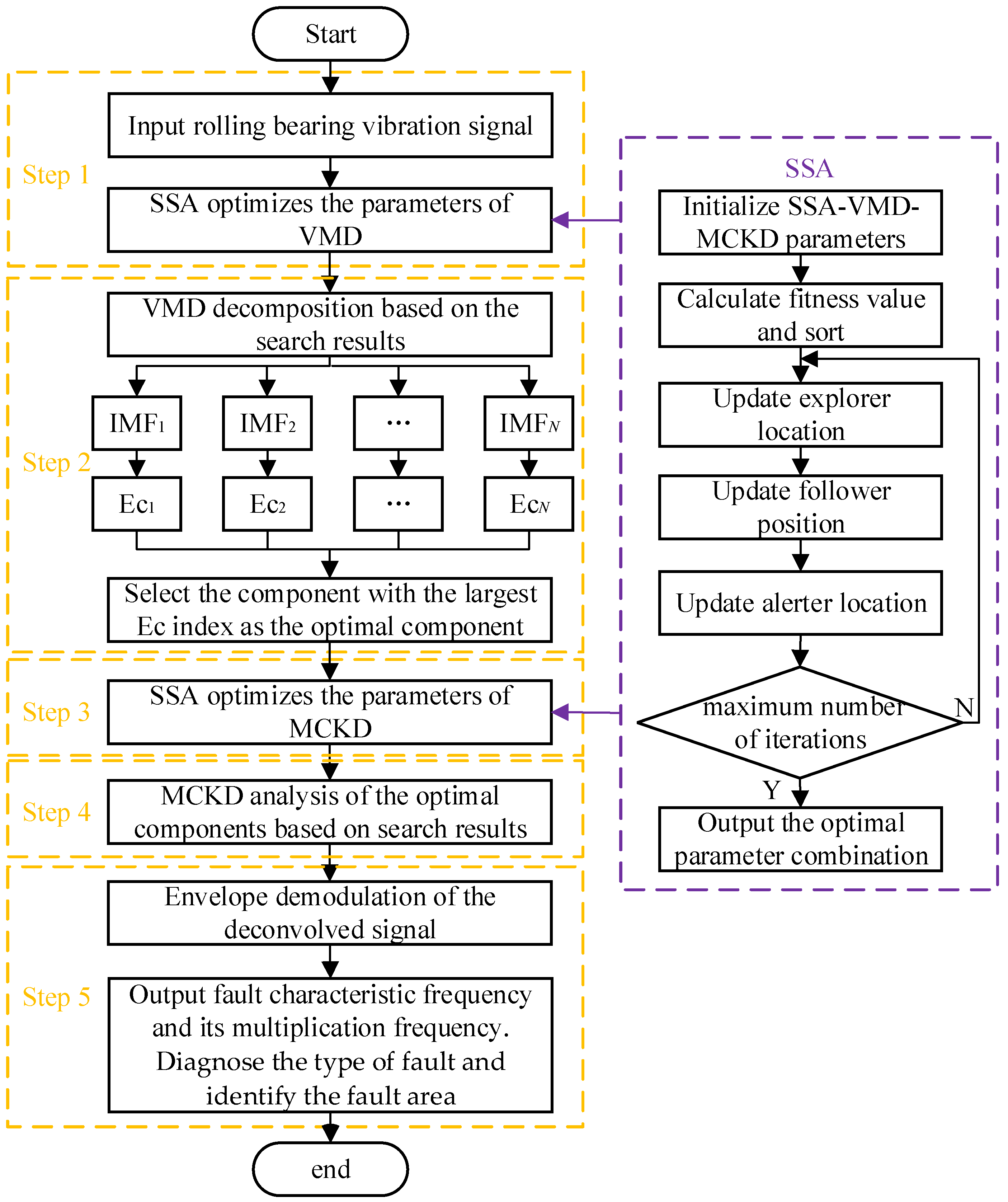

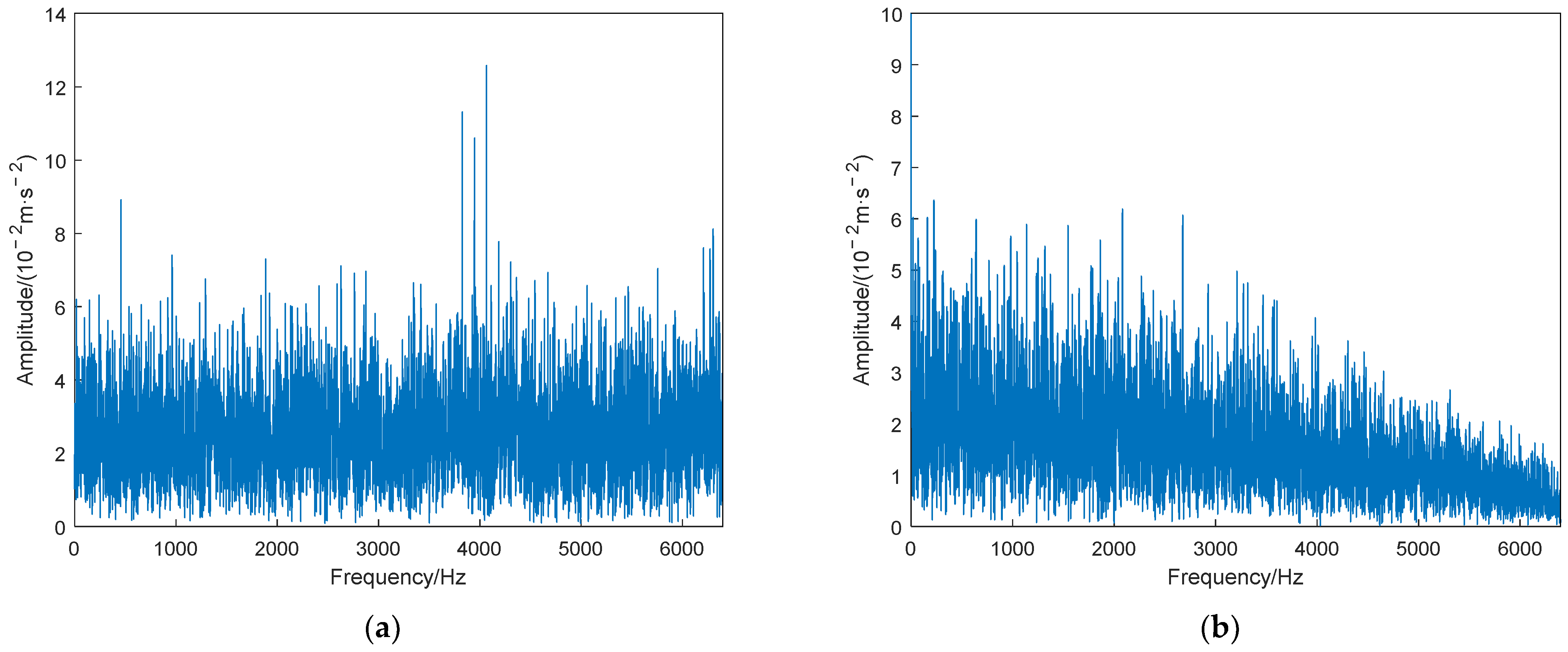
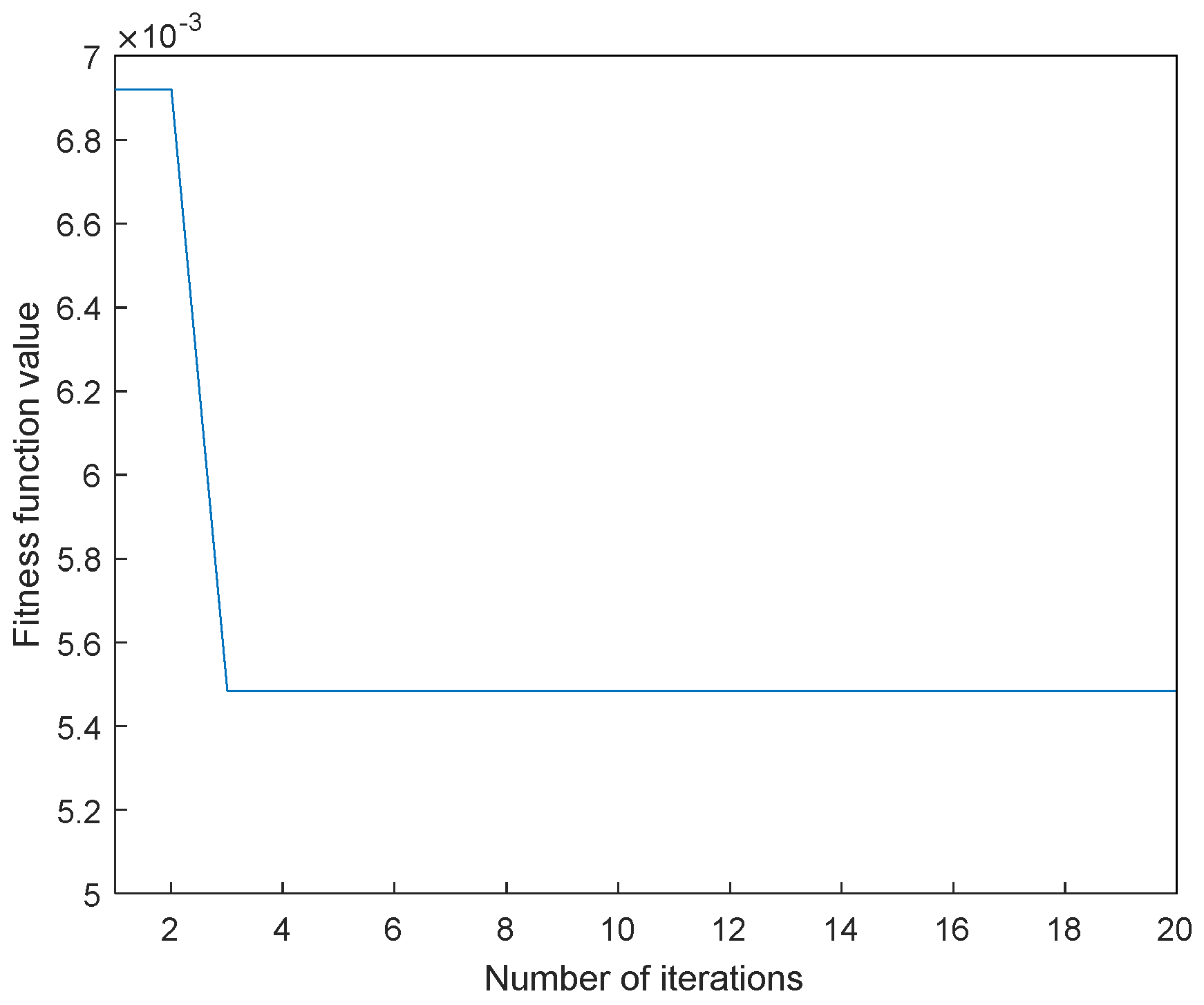
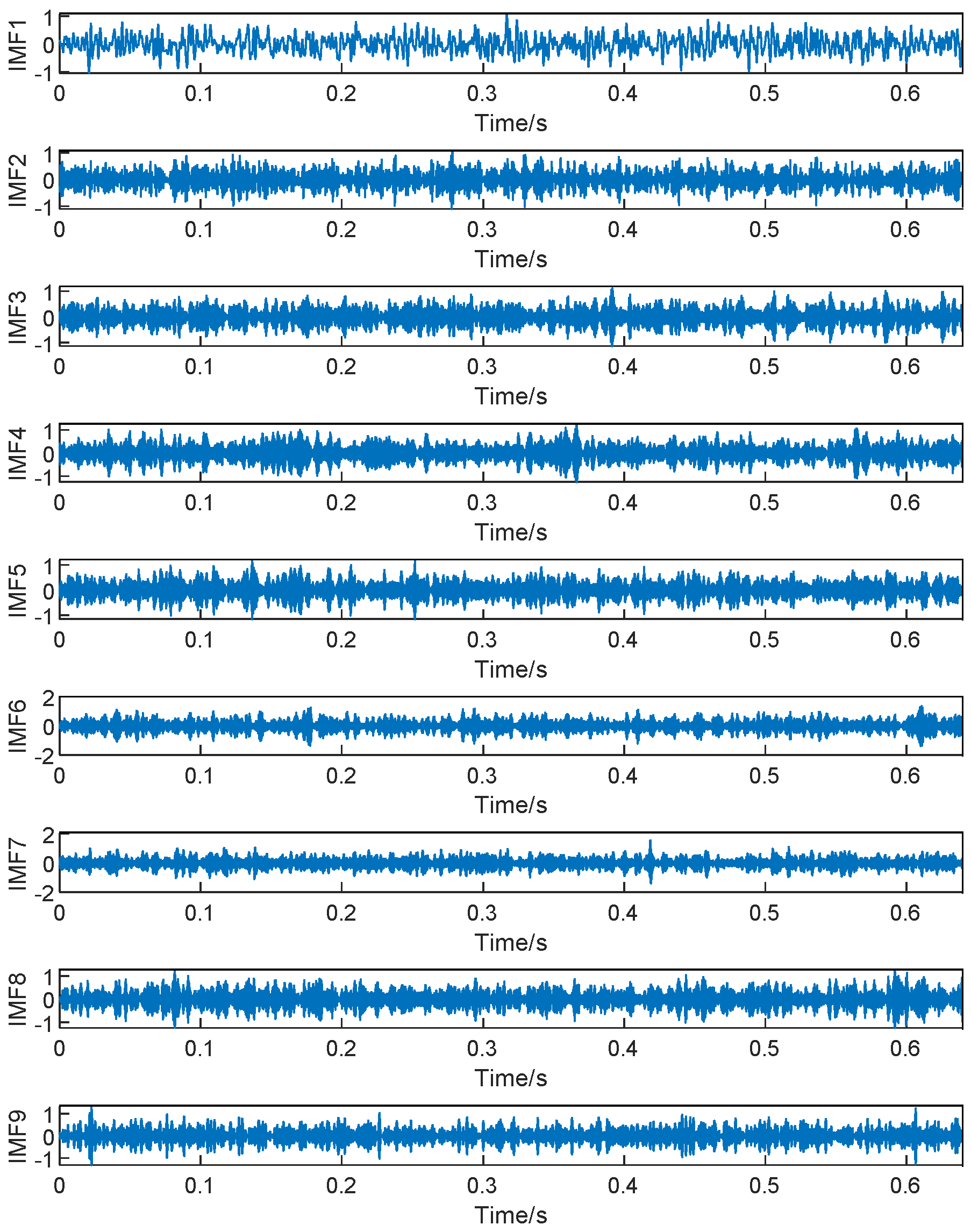
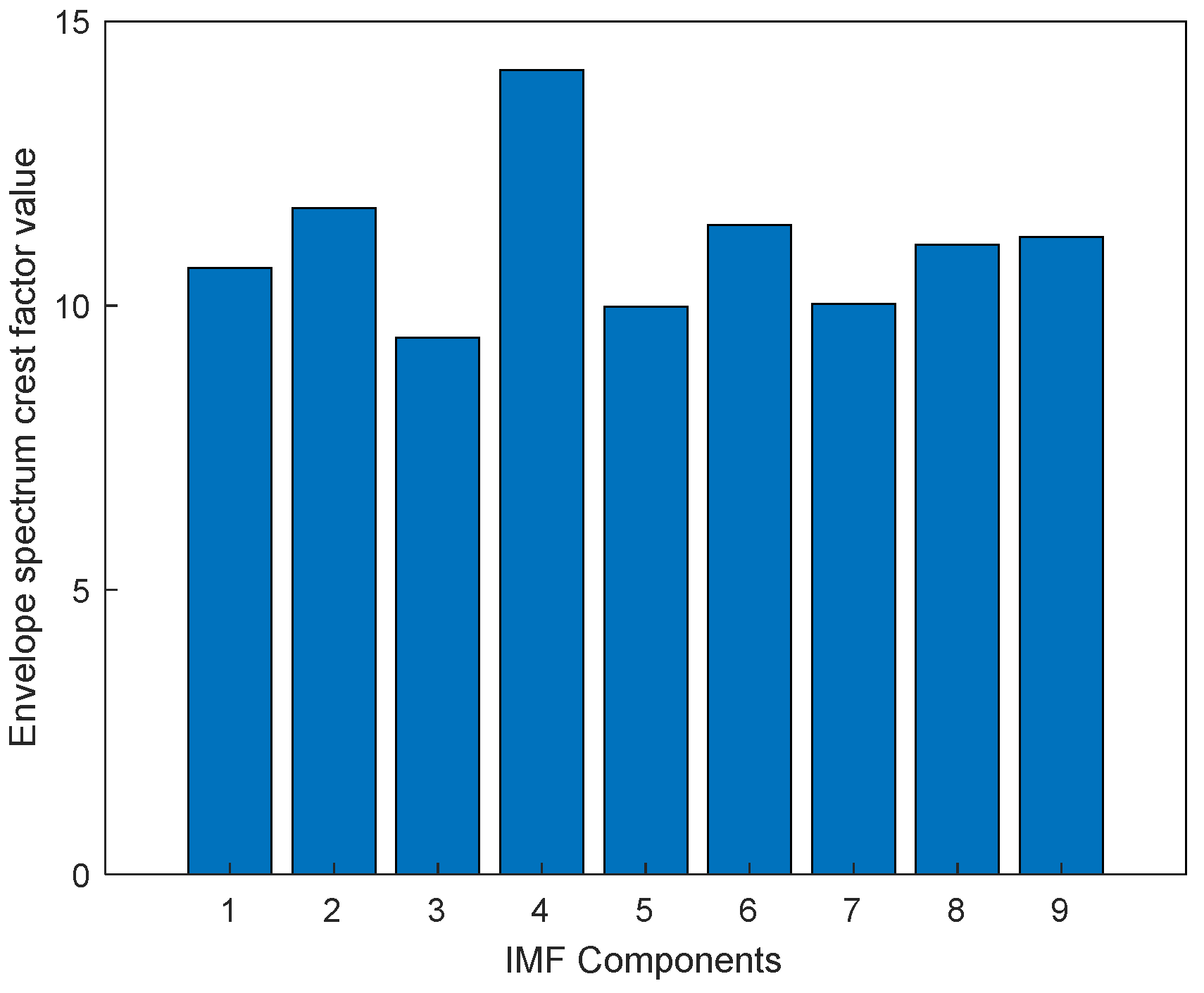
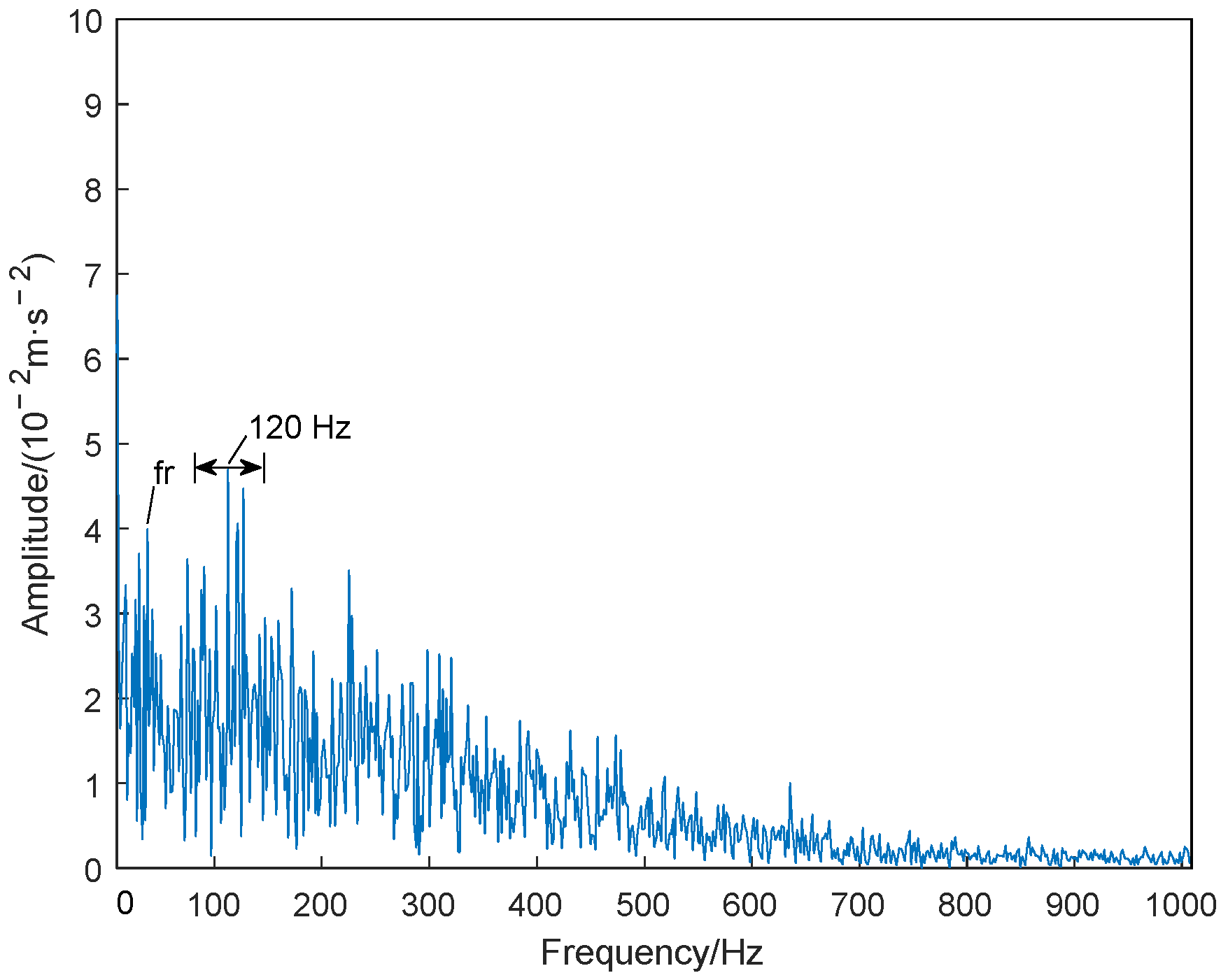
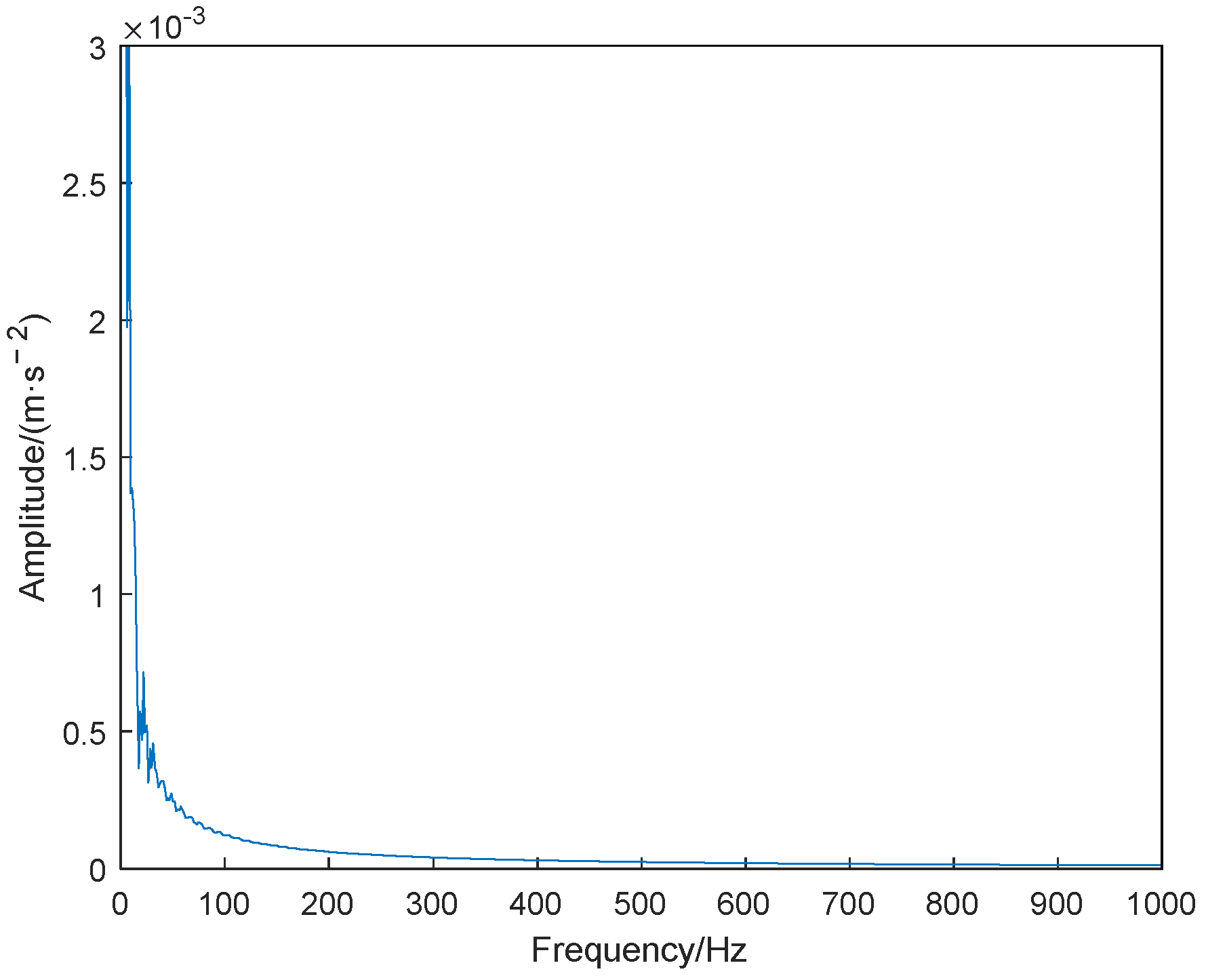
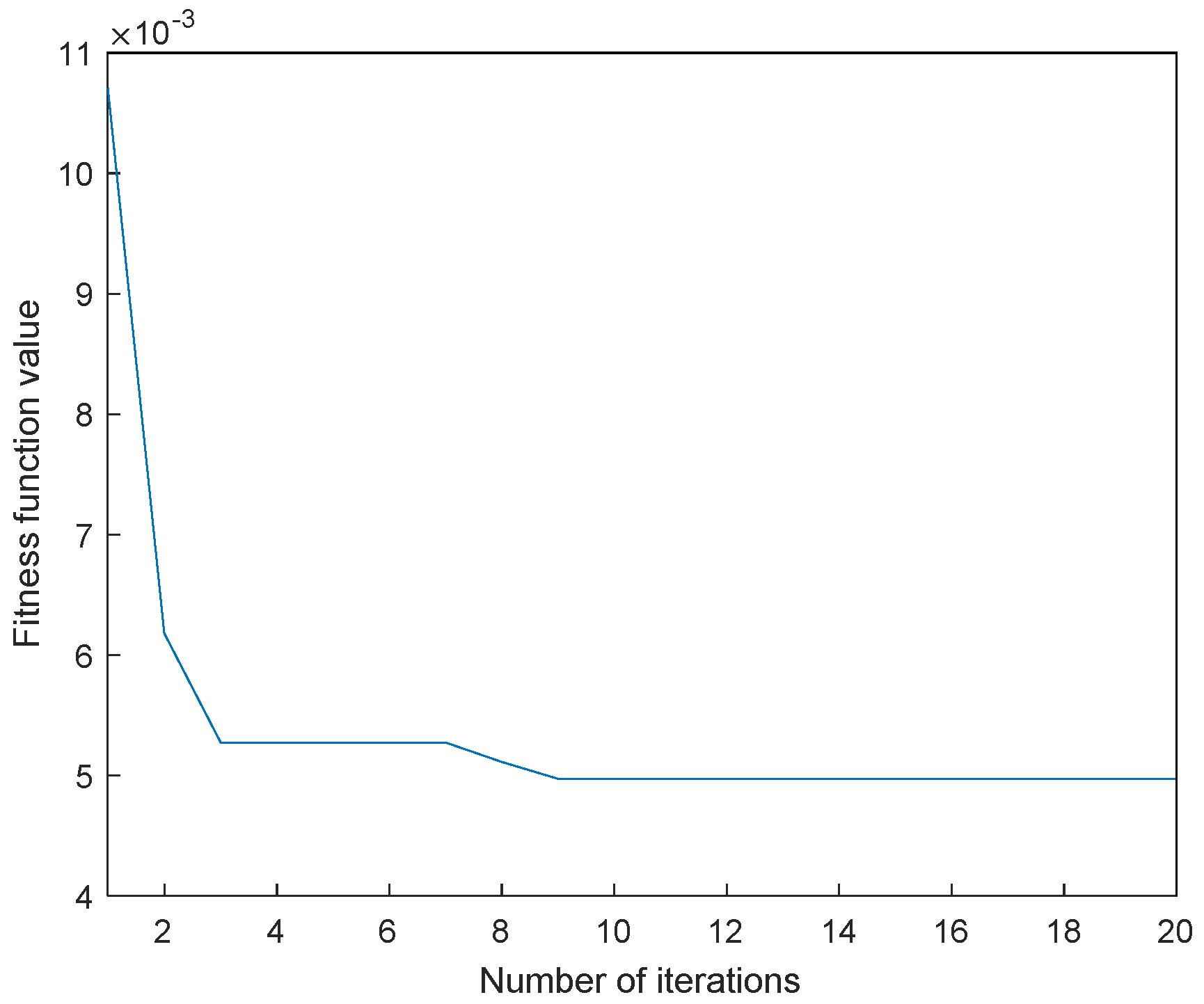
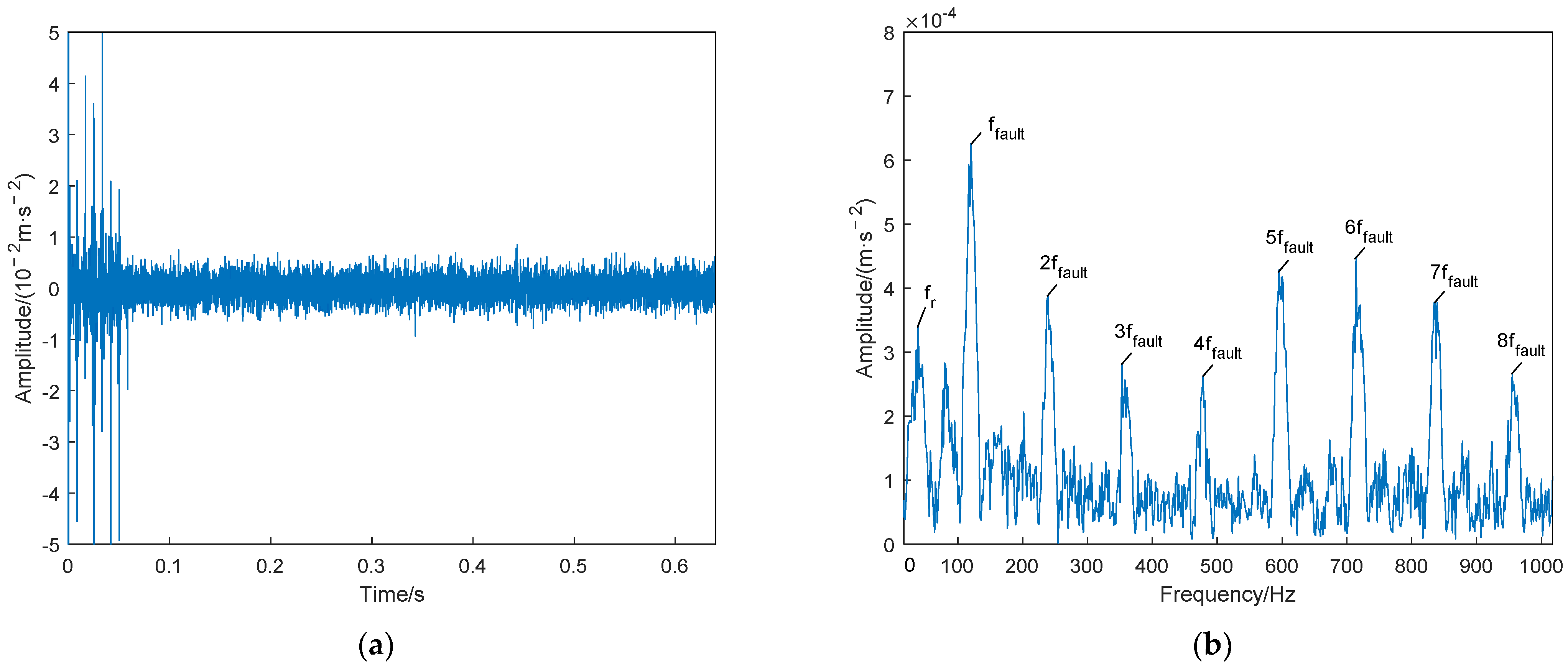

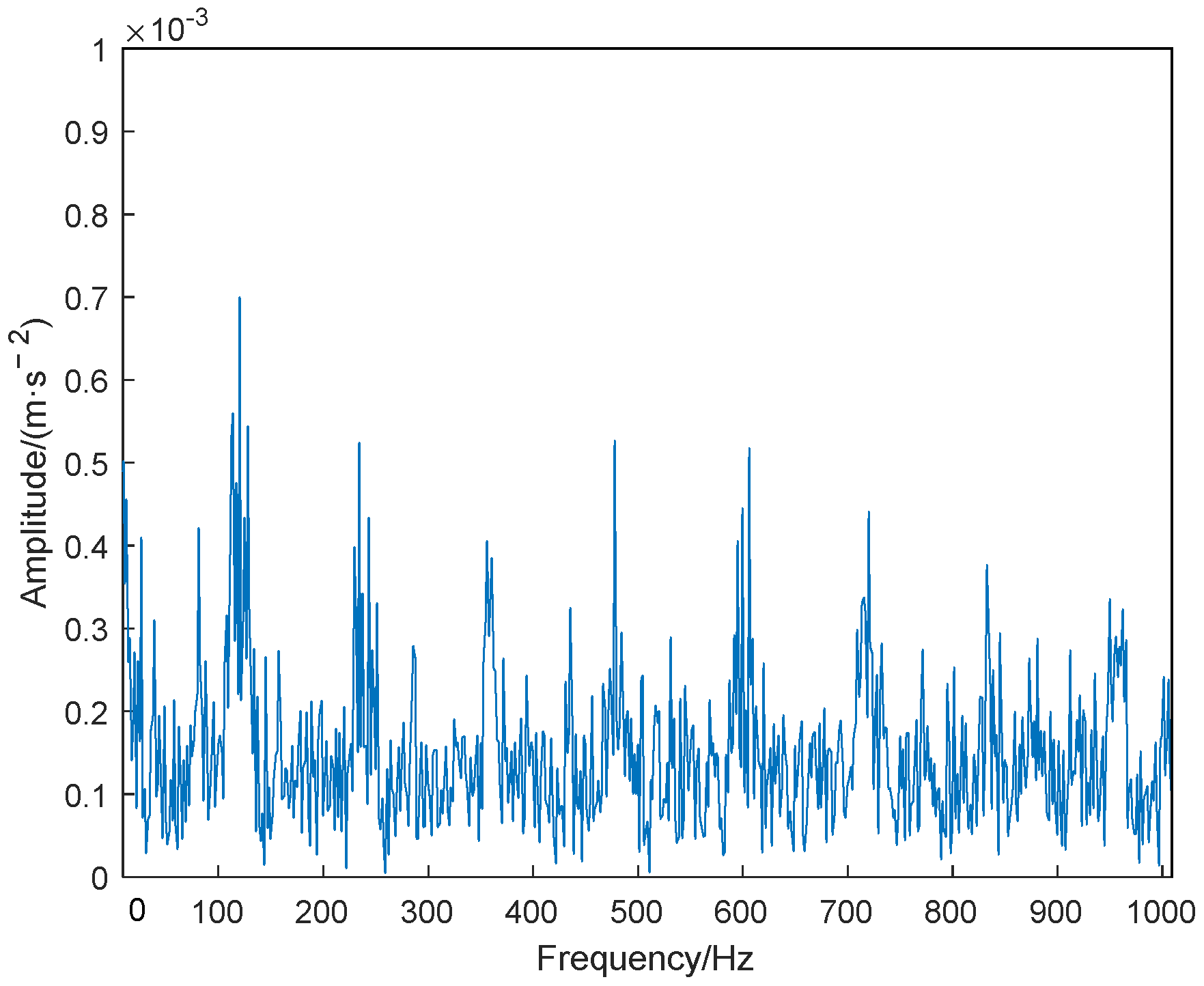
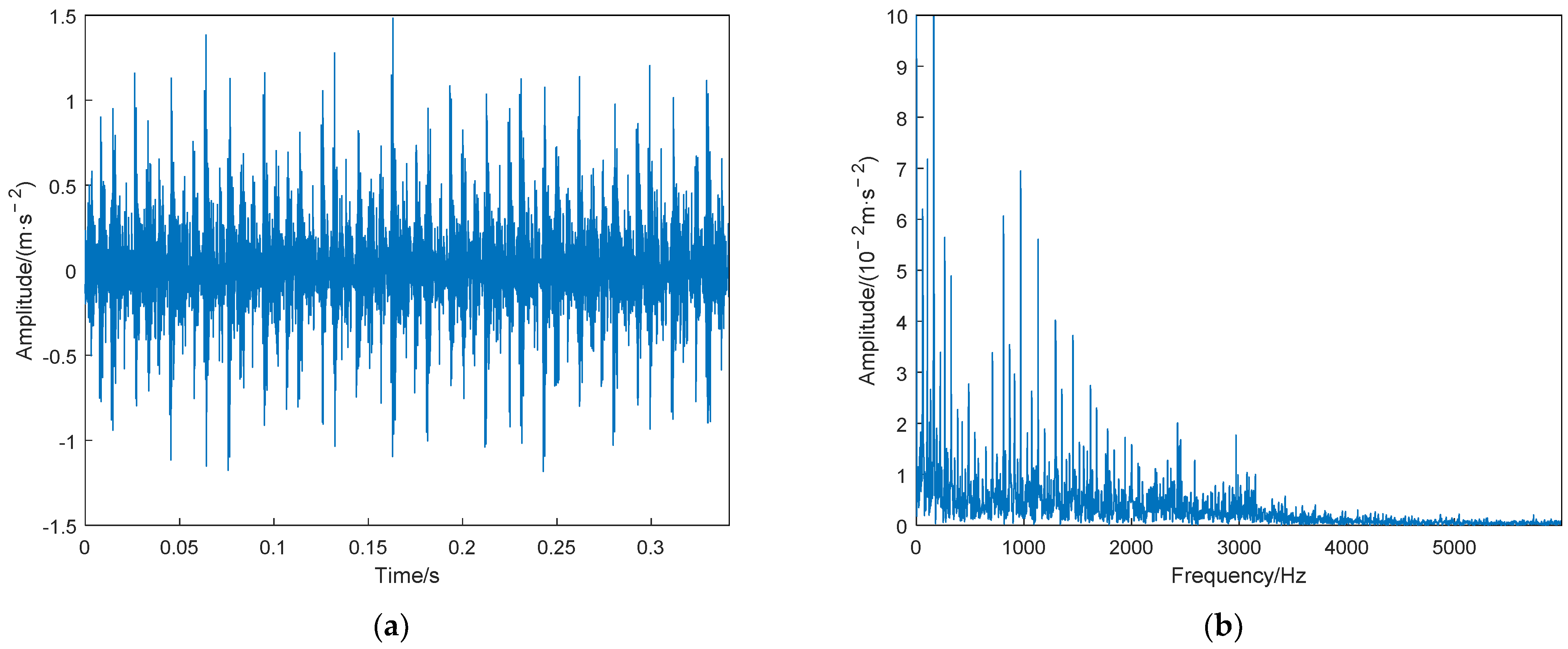

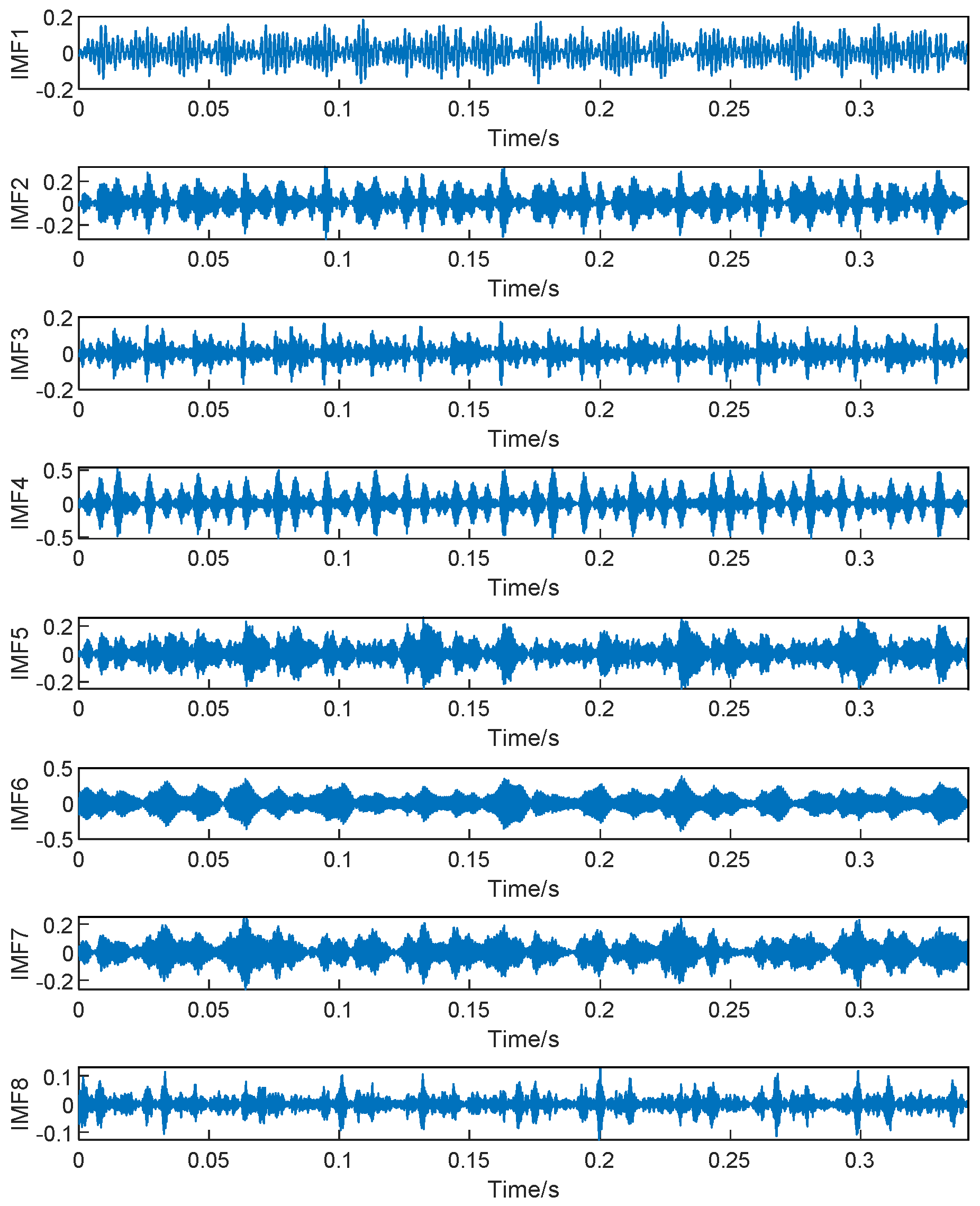
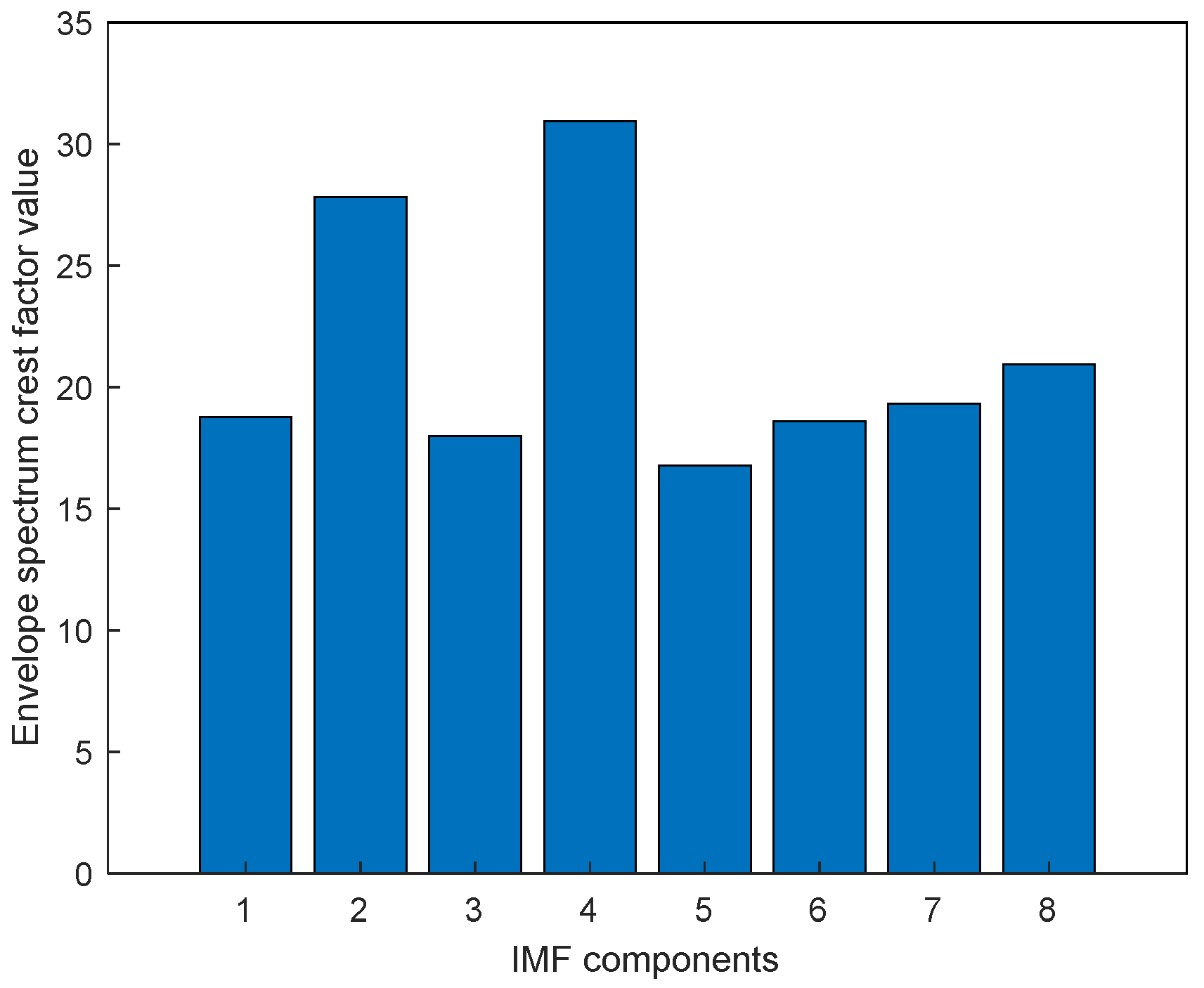
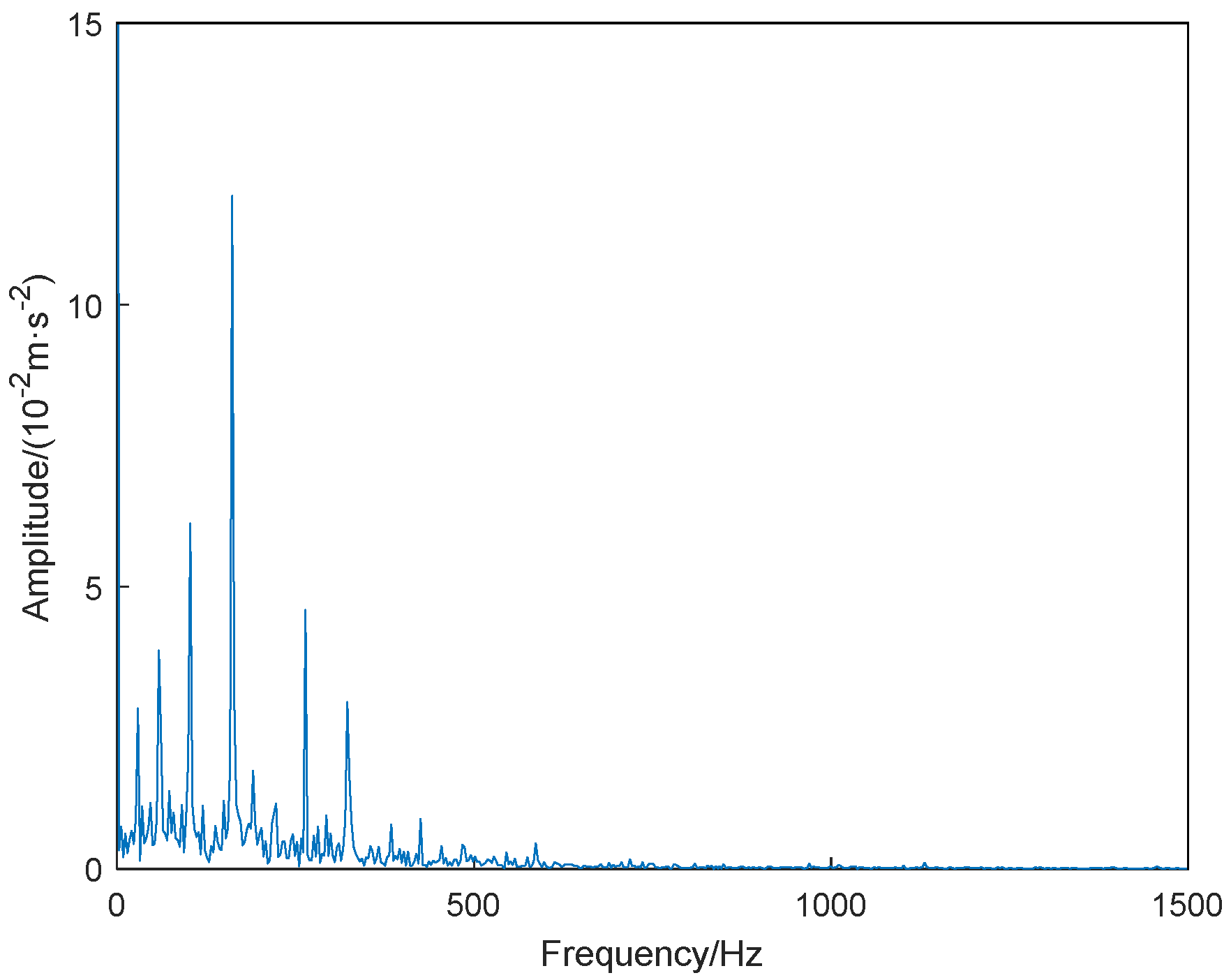
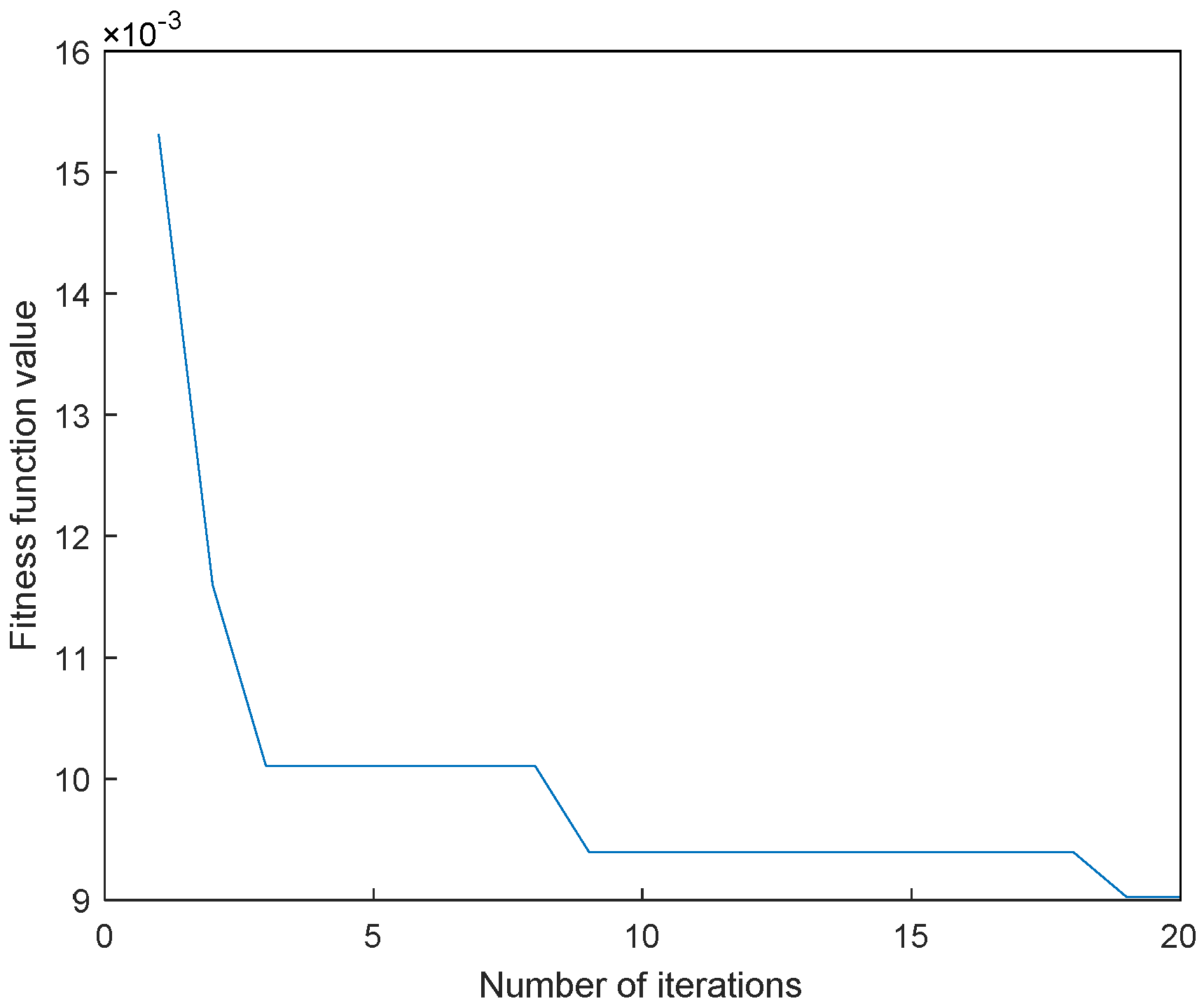

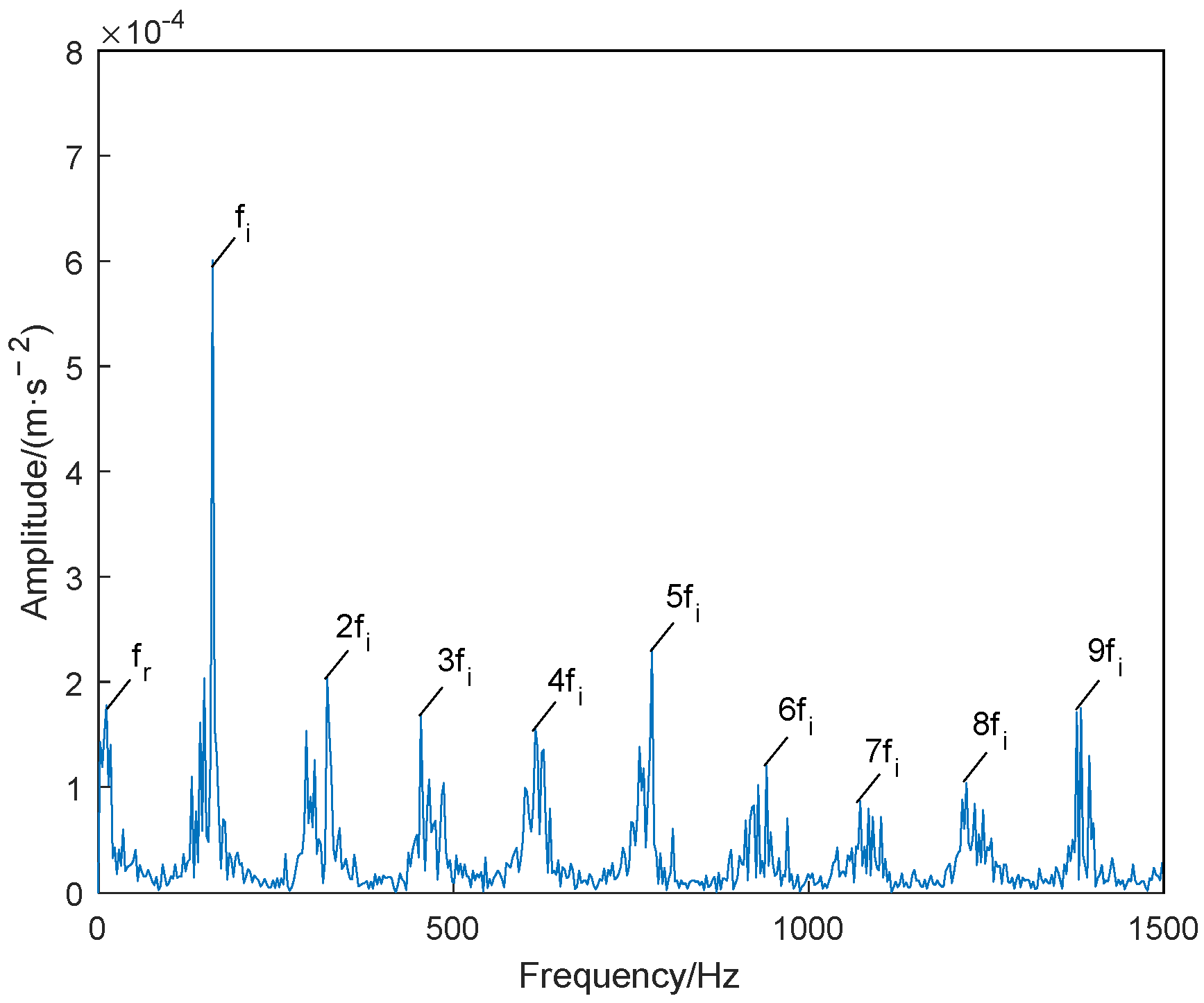


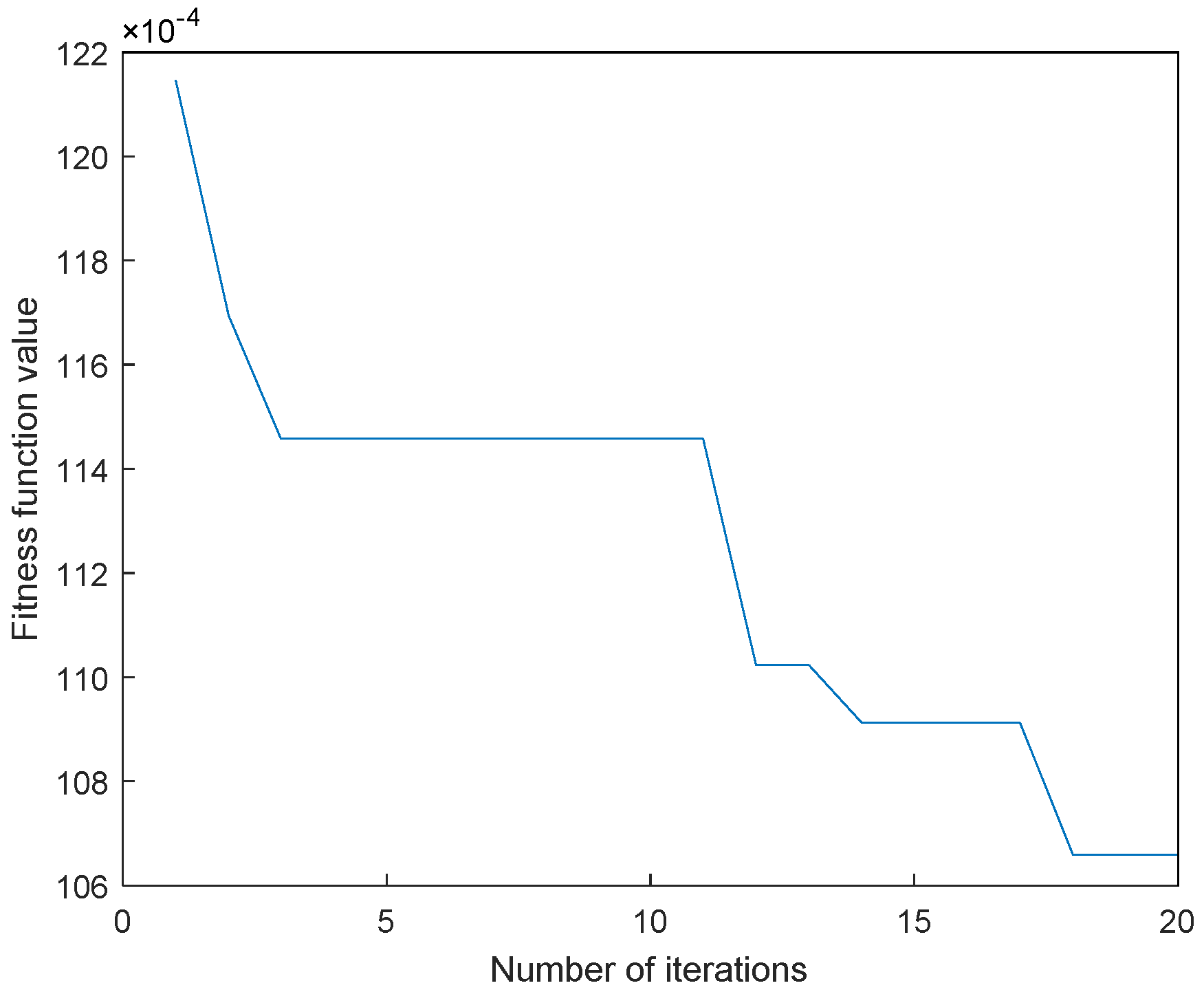

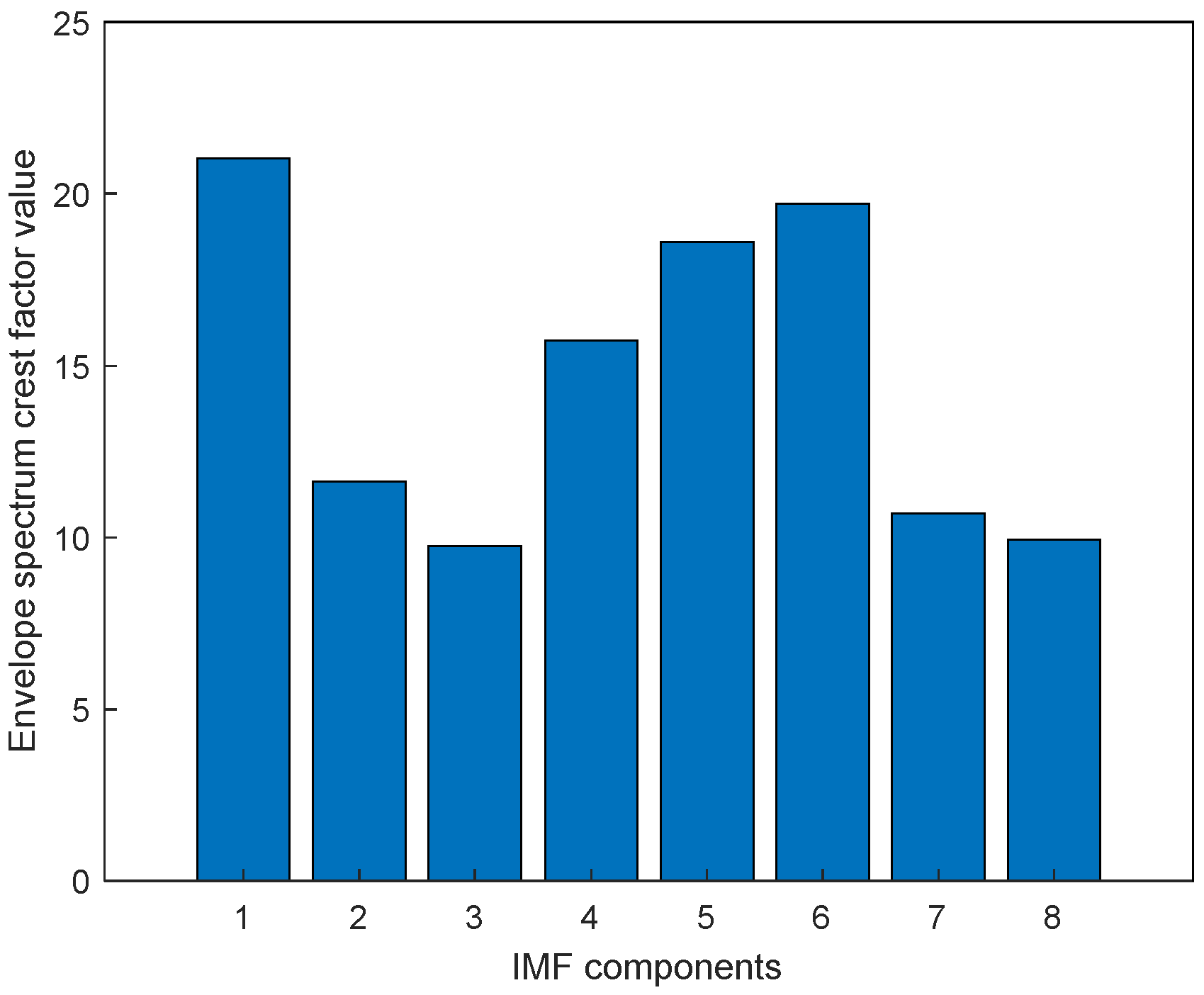

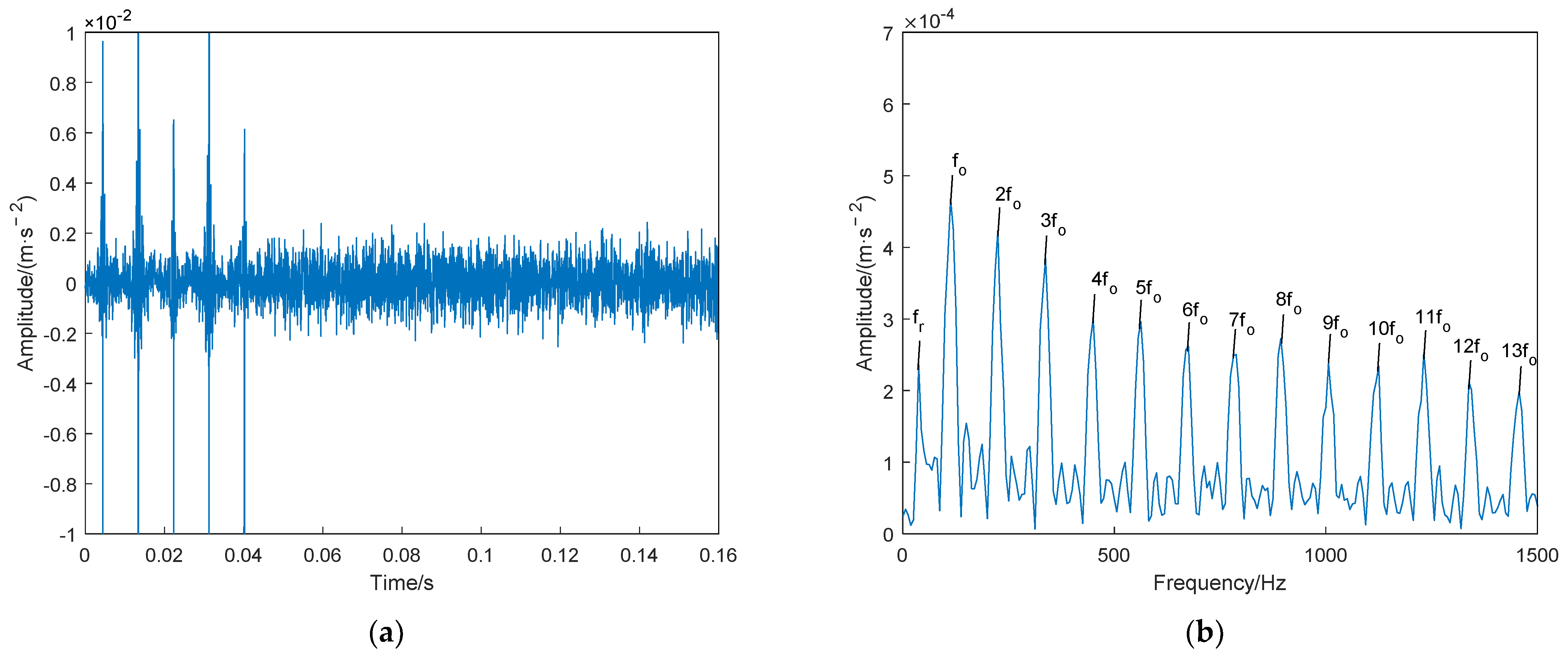
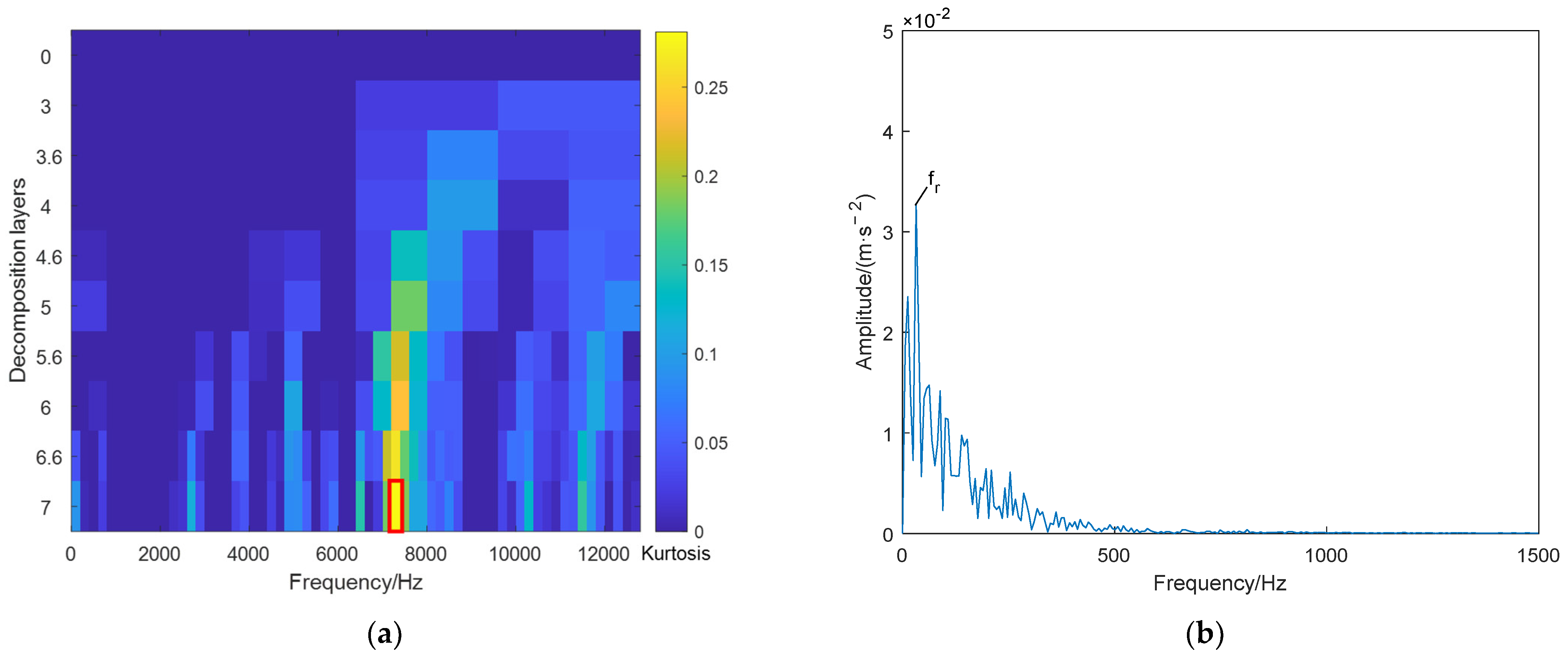
Publisher’s Note: MDPI stays neutral with regard to jurisdictional claims in published maps and institutional affiliations. |
© 2022 by the authors. Licensee MDPI, Basel, Switzerland. This article is an open access article distributed under the terms and conditions of the Creative Commons Attribution (CC BY) license (https://creativecommons.org/licenses/by/4.0/).
Share and Cite
Liu, Z.; Li, S.; Wang, R.; Jia, X. Research on Fault Feature Extraction Method of Rolling Bearing Based on SSA–VMD–MCKD. Electronics 2022, 11, 3404. https://doi.org/10.3390/electronics11203404
Liu Z, Li S, Wang R, Jia X. Research on Fault Feature Extraction Method of Rolling Bearing Based on SSA–VMD–MCKD. Electronics. 2022; 11(20):3404. https://doi.org/10.3390/electronics11203404
Chicago/Turabian StyleLiu, Zichang, Siyu Li, Rongcai Wang, and Xisheng Jia. 2022. "Research on Fault Feature Extraction Method of Rolling Bearing Based on SSA–VMD–MCKD" Electronics 11, no. 20: 3404. https://doi.org/10.3390/electronics11203404



